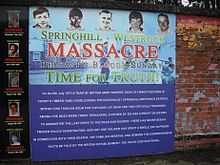Springhill Massacre
| Springhill Massacre | |
|---|---|
| Part of The Troubles | |
 Poster demanding an inquiry in the Beechmount area of Belfast | |
| Location | Belfast, Northern Ireland |
| Date | 9 July 1972 |
| Attack type | Sniper shooting, mass murder |
| Weapon(s) | Sniper rifles |
| Deaths | 5 |
| Injured (non-fatal) | 2 |
| Perpetrators | British Army snipers |
The Springhill Massacre[1] was a shooting incident on 9 July 1972 in the Springhill estate in west Belfast, Northern Ireland. Five civilians were killed by British Army snipers who were in a timber yard.
Background
The Northern Ireland Troubles had been raging for three years and hundreds had already been killed by the two warring factions in Northern Ireland, Irish republicans wanting civil rights and unification with the Republic of Ireland, and Ulster unionists, opposing civil rights and Irish reunification. The British Army was deployed to keep the two groups apart but Nationalists complained about the Army's heavy-handedness.[2] Violence had been taking place all day and the five dead were part of ten people killed that day.[3]
The shootings
Provisional IRA version of events
According to a Provisional IRA (IRA) statement on 10 July, Army snipers took up sniping positions in Corry's timber yard and reinforced them with sandbags. Two cars pulled into Springhill and the snipers fired two shots at them. One of the cars fled while the other drove a short distance and stopped, the occupants got out and the snipers opened fire again, One occupant was shot in the back of the head and was seriously wounded. A resident rushed to help the injured man but was immediately shot in the arm. The man's brother and his friend ran to the downed occupant but both were shot by the snipers. At some point during this time a 13-year-old girl was fatally shot by the snipers. The parish priest and a passer-by (the priest was waving a white cloth) rushed to her but a sniper killed both with a single bullet that passed through both their heads. All the victims were unarmed.[3]
Army version of events
The Army disputed this version of events and claimed its troops were fired on first by the IRA, ending a temporary IRA ceasefire. An Army spokesman stated: “There has been a heavy exchange of fire between the IRA and troops. Some of the dead and wounded were undoubtedly caught in the crossfire.” On 10 July, the Army claimed that it had killed terrorists.[3] An open verdict was recorded at the inquest into the events.[3]
The deceased

- Margaret Gargan, 13, shot in the head
- John Dougal, 16, shot in the chest
- David McCafferty, 15, shot in the chest
- Patrick Butler, 39, shot in the head
- Father Noel Fitzpatrick, 40, shot in the neck
Impact
In May 2005, Michael Norman, a former SAS trooper, was found shot dead in his car with photographs of the incident. It is unclear whether he was involved or whether he had committed suicide.[4]
See also
- Ballymurphy massacre
References
- ↑ RTE News. "Springhill survivors demand independent inquiry". 2 August 1999. Retrieved 22 March 2011
- ↑ English, Richard (2003). Armed Struggle: The History of the IRA. Pan Books. p. 136. ISBN 0-330-49388-4.
- ↑ 3.0 3.1 3.2 3.3 Irish News 5 May 1999
- ↑ Sunday Mirror, 8 May 2005
External links
- CAIN - Sutton Index of Deaths - 9 July 1972
- CAIN - Memorials - Springhill Massacre
- Relatives for Justice - Springhill Massacre, July 1972
- "The Springhill massacre: Adams demands an inquiry" - An Phoblacht
- "British military campaign ends but questions remain unanswered" - An Phoblacht
- "Springhill survivors demand independent inquiry" - RTÉ News
- McLaughlin, C. 'Recording Memories from Political Violence', Intellect Books, 2010.